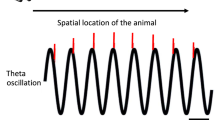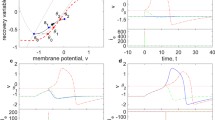Abstract
It is much debated on what time scale information is encoded by neuronal spike activity. With a phenomenological model that transforms time-dependent membrane potential fluctuations into spike trains, we investigate constraints for the timing of spikes and for synchronous activity of neurons with common input. The model of spike generation has a variable threshold that depends on the time elapsed since the previous action potential and on the preceding membrane potential changes. To ensure that the model operates in a biologically meaningful range, the model was adjusted to fit the responses of a fly visual interneuron to motion stimuli. The dependence of spike timing on the membrane potential dynamics was analyzed. Fast membrane potential fluctuations are needed to trigger spikes with a high temporal precision. Slow fluctuations lead to spike activity with a rate about proportional to the membrane potential. Thus, for a given level of stochastic input, the frequency range of membrane potential fluctuations induced by a stimulus determines whether a neuron can use a rate code or a temporal code. The relationship between the steepness of membrane potential fluctuations and the timing of spikes has also implications for synchronous activity in neurons with common input. Fast membrane potential changes must be shared by the neurons to produce synchronous activity.
Similar content being viewed by others
References
Alonso JM, Usrey W, Reid R (1996) Precisely correlated firing in cells of the lateral geniculate nucleus. Nature 383:815-819.
Bair W (1999) Spike timing in the mammalian visual system. Curr. Opin. Neurobiol. 9:447-453.
Bair W, Koch C (1996) Temporal precision of spike trains in extrastriate cortex of the behaving macaque monkey. Neural Comput. 8:1185-1202.
Berry MJ, Warland DK, Meister M (1997) The structure and precision of retinal spike trains. PNAS, USA 94:5411-5416.
Bialek W, Rieke F (1992) Reliability and information transmission in spiking neurons. TINS 15:428-434.
Britten K, Shadlen M, Newsome W, Movshon J (1993) Responses of neurons in macaque MT to stochastic motion signals. Vis. Neurosci. 10:1157-1169.
Brivanlou I, Warland D, Meister M (1998) Mechanisms of concerted firing among retinal ganglion cells. Neuron 20:527-539.
Brody C (1999) Correlations without synchrony. Neural Comput. 11:1537-1551.
Buračas G, Zador A, DeWeese M, Albright T (1998) Efficient discrimination of temporal patterns by motion-sensitive neurons in primate visual cortex. Neuron 20:956-969.
Calvin W, Stevens C (1968) Synaptic noise and other sources of randomness in motoneuron interspike intervals. J. Neurophysiol. 31:574-587.
Carr C, Friedmann M (1999) Evolution of time coding systems. Neural Comput. 11:1-20.
Cecchi G, Sigman M, Alonso JM, Martinez L, Chialvo D, Magnasco M (2000) Noise in neurons is message-dependent. Proc. Natl. Acad. Sci. USA 97:5557-5561.
de Ruyter van Steveninck R, Bialek W (1988) Real-time performance of a movement-sensitive neuron in the blowfly visual system: Coding and information transfer in short spike sequences. Proc. R. Soc. Lond. B 234:379-414.
de Ruyter van Steveninck R, Bialek W (1995) Reliability and statistical efficiency of a blowfly movement sensitive neuron. Phil. Trans. R. Soc. Lond. B 348:321-340.
de Ruyter van Steveninck R, Borst A, Bialek W (2000) Real-time encoding of motion: Answerable questions and questionable answers from the fly's visual system. In: Zanker JM, Zeil J, eds. Visual Motion. Springer, Heidelberg (in press).
Ebbinghaus C, Diesmann M, Rotter S, Aertsen A (1997) The neural firing threshold: Can I help U? In: Elsner N, Wässle H, eds. Göttingen Neurobiology Report 1997. Proceedings of the 25th G¨ottingen Neurobiology Conference 1997. Thieme, Stuttgart p. 624.
Eckhorn R, Reitboeck H, Arndt M, Dicke P (1990) Feature linking via synchronization among distributed assemblies: Simulations of results from cat visual cortex. Neural Comput. 2:293-307.
Egelhaaf M, Borst A (1993) Movement detection in arthropods. In: Miles FA, Wallman J, eds. Visual Motion and Its Role in the Stabilization of Gaze. Elsevier, Amsterdam. pp. 53-77.
Egelhaaf M, Reichardt W (1987) Dynamic response properties of movement detectors: Theoretical analysis and electrophysiological investigation in the fly system of the fly. Biol. Cybern. 56: 69-87.
Egelhaaf M, Warzecha, A-K (1999) Encoding of motion in real time by the fly visual system. Curr. Opin. Neurobiol. 9:454-460.
Gerstner W, van Hemmen L (1992) Associative memory in a network of "spiking" neurons. Network 3:139-164.
Gestri G, Mastebroek H, Zaagman W (1980) Stochastic constancy, variability and adaptation of spike generation: Performance of a giant neuron in the visual system of the fly. Biol. Cybern. 38:31-40.
Haag J, Borst A (1996) Amplifications of high-frequency synaptic inputs by active dendritic membrane processes. Nature 379:639-641.
Haag J, Borst A (1997) Encoding of visual motion information and reliability in spiking and graded potential neurons. J. Neurosci. 17:4809-4819.
Haag J, Borst A (1998) Active membrane properties and signal encoding in graded potential neurons. J. Neurosci. 18:7972-7986.
Haag J, Vermeulen A, Borst A (1999) The intrinsic electrophysiological characteristics of fly lobula plate tangential cells: III. Visual response properties. J. Comp. Neurosci. 7:213-234.
Hausen K (1981) Monocular and binocular computation of motion in the lobula plate of the fly. Verh. Dtsch. Zool. Ges. 74:49-70.
Hausen K (1982) Motion sensitive interneurons in the optomotor system of the fly. II. The horizontal cells: Receptive field organization and response characteristics. Biol. Cybern. 46:67-79.
Heck D, Rotter S, Aertsen A (1993) Spike generation in cortical neurons: Probabilistic threshold function shows intrinsic and long-lasting dynamics. In: Aertsen A, ed. Brain Theory. Elsevier, Amsterdam. pp. 241-249.
Heiligenberg W (1991) Neural Nets in Electric Fish. MIT Press, Cambridge, MA.
Hengstenberg R (1982) Common visual response properties of giant vertical cells in the lobula plate of the blowfly Calliphora. J. Comp. Physiol. 149:179-193.
Hodgkin A, Huxley A (1952) A quantitative description of ion currents and its applications to conduction and excitation in nerve membranes. J. Physiol. (London) 117:500-544.
Johnston D, Wu SS (1995) Foundations of Cellular Neurophysiology. MIT Press, Cambridge, MA.
Kandel E, Schwartz J, Jessell T (1995) Essentials of neural science and behavior. Appleton & Lange, Norwalk, CT.
Kawasaki M (1997) Sensory hyperacuity in the jamming avoidance response of weakly electric fish. Curr. Opin. Neurobiol. 7:473-479.
Koch C (1999) Biophysics of Computation: Information Processing in Single Neurons. Oxford University Press, New York.
Lampl I, Reichova I, Ferster D (1999) Synchronous membrane potential fluctuations in neurons of the cat visual cortex. Neuron 22:361-374.
Land MF, Collet TS (1974) Chasing behaviour of houseflys (Fannia caicularis). J. Comp. Physiol. 89:331-357.
Levine M (1998) Models for the cross-correlation between retinal ganglion cells. Biol. Cybern. 79:367-376.
Lisberger SG, Movshon JA (1999) Visual motion analysis for pursuit eye movements in area MT of macaque monkeys. J. Neurophysiol. 19:2224-2246.
Maass W (1996) Networks of spiking neurons: The third generation of neural network models. Neur Networks 10:1659-1671.
Maddess T, Laughlin SB (1985) Adaptation of the motion-sensitive neuronH1is generated locally and governed by contrast frequency. Proc. R. Soc. Lond. B 225:251-275.
Mainen Z, Sejnowski T (1995) Reliability of spike timing in neocortical neurons. Science 268:1503-1506.
Manwani A, Koch C (1999a) Detecting and estimating signals in noisy cable structures: I. Neuronal noise sources. Neural Comput. 11:1797-1829.
Manwani A, Koch C (1999b) Detecting and estimating signals in noisy cable structures: II. Information theoretical analysis. Neural Comput. 11:1831-1873.
Mastebroek H (1974) Stochastic structure of neural activity in the visual system of the blowfly. Ph.D. thesis, Rijksuniversiteit te Groningen.
Mechler F, Victor JD, Purpura KP, Shapley R (1998) Robust temporal coding of contrast by V1 neurons for transient but not for steady-state stimuli. J. Neurosci. 18:6583-6598.
Pollen DA, Andrews BW, Feldon SE (1978) Spatial frequency selectivity of periodic complex cells in the visual cortex of the cat. Vis. Res. 18:665-682.
Reich D, Victor J, Knight B (1998) The power ratio and the interval map: Spiking models and extracellular recordings. J. Neurosci. 18:10090-10104.
Reich D, Victor J, Kneight B, Ozaki T, Kaplan E (1997) Response variability and timing precision of neuronal spike trains in vivo. J. Neurophysiol. 77:2836-2841.
Ritz R, Sejnowski T (1997) Correlation coding in stochastic neural networks. In: Gerstner W, Germona A, Hasler M, Nicaud J-D, eds. Proceedings ICANW 97. Springer, Heidelberg, pp. 79-84.
Schilstra C, Hateren JH van (1999) Blowfly flight and optic flow. I. Thorax kinematics and flight dynamics. J. Exp. Biol. 202:1481-1490.
Schneidman E, Freedman B, Segev I (1998) Ion channel stochasticity may be critical in determining the reliability and precision of spike timing. Neural Comput. 10:1679-1703.
Shadlen M, Newsome W (1994) Noise, neural codes and cortical organization. Curr. Opin. Neurobiol. 4:569-579.
Shadlen M, Newsome W (1998) The variable discharge of cortical neurons: Implications for connectivity, computation, and information coding. J. Neurosci. 18:3870-3896.
Softky W (1995) Simple codes versus efficient codes. Curr. Opin. Neurobiol. 5:239-247.
Softky W, Koch C (1993) The highly irregular firing of cortical cells is inconsistent with temporal integration of random epsps. J. Neurosci. 13:334-350.
Stevens C, Zador A (1998) Input synchrony and the irregular firing of cortical neurons. Nature Neurosci 1:210-217.
Tolhurst D, Movshon JA, Dean A (1983) The statistical reliability of signals in single neurons in cat and monkey visual cortex. Vis. Res. 23:775-785.
Usrey WM, Reid RC (1999) Synchronous activity in the visual system. Ann. Rev. Physiol 61:435-456.
Usrey WM, Reppas JB, Reid RC (1998) Paired-spike interactions and synaptic efficacy of retinal inputs to the thalamus. Nature 395:384-387.
van Hateren JH, Schilstra C (1999) Blowfly flight and optic flow. II. Head movements during flight. J. Exp. Biol. 202:1491-1500.
Vogels R, Spileers W, Orban G (1989) The response variability of striate cortical neurons in behaving monkey. Exp. Brain. Res. 77:432-436.
Wagner H (1986) Flight performance and visual control of flight of the free flying housefly (Musca domestica L.) II. Pursuit of targets. Phil. Trans. R. Soc. Lond. B 312:553-579.
Warzecha AK, Egelhaaf M (1996) Intrinsic properties of biological motion detectors prevent the optomotor control system from getting unstable. Phil. Trans. R. Soc. Lond. B 351:1579-1591.
Warzecha AK, Egelhaaf M (1997) How reliably does a neuron in the visual motion pathway of the fly encode behaviourally relevant information? Eur. J. Neurosci. 9:1365-1374.
Warzecha AK, Egelhaaf M (1999) Variability in spike trains during constant and dynamic stimulation. Science 283:1927-1930.
Warzecha AK, Egelhaaf M (2000) Neuronal encoding of visual motion in real-time In: Zanker JM, Zeil J, eds. Visual Motion. Springer, Heidelberg (in press).
Warzecha AK, Kretzberg J, Egelhaaf M (1998) Temporal precision of the encoding of motion information by visual interneurons. Curr. Biol. 8:359-368.
Warzecha AK, Kretzberg J, Egelhaaf M (2000) Reliability of a fly motion sensitive neuron depends on stimulus parameters. J. Neurosci. 20:8886-8896.
White JA, Rubinstein JT, Kay AR (2000) Channel noise in neurons. Trends Neurosci. 23:131-137.
Wolf-Oberhollenzer F, Kirschfeld K (1990) Temporal frequency dependence in motion-sensitive neurons of the accessory optic system of the pigeon. Naturwiss. 77:296-298.
Zador A (1998) Impact of synaptic unreliability on the information transmitted by spiking neurons. J. Neurophysiol. 79:1219-1229.
Author information
Authors and Affiliations
Rights and permissions
About this article
Cite this article
Kretzberg, J., Egelhaaf, M. & Warzecha, AK. Membrane Potential Fluctuations Determine the Precision of Spike Timing and Synchronous Activity: A Model Study. J Comput Neurosci 10, 79–97 (2001). https://doi.org/10.1023/A:1008972111122
Issue Date:
DOI: https://doi.org/10.1023/A:1008972111122




